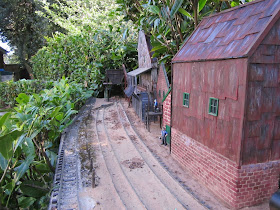 Why a 15" gauge feeder?
Why a 15" gauge feeder?
The copper mines which provide the main rationale for the Peckforton Light Railway are served by a 15" gauge railway system. There is a clear reason for this choice of a 'minimum gauge' feeder line for the Peckforton Railway. In my hypothetical history (see A history of the railway), the local landowner and keen engineer, Lord Tollemache, was the main driving force behind the development of the mines and the railway. I've assumed he would have been very familiar with the 15" gauge Eaton Railway which had been constructed a short distance away from Peckforton on the Duke of Westminster's estate by the pioneer of minimum gauge railways, Sir Arthur Heywood. It seems reasonable that Lord Tollemache would have experimented with a minimum gauge railway to both serve his estate and to negotiate the narrow galleries and tunnels of his copper mines.
The location
Having just completed the buildings for the copper mine (See Progress Report 45) I felt the need to construct a short stretch of Gn15 railway to represent the transportation of the ore and spoil from the mines to the crushing shed and the loading chutes. This, of course, would require some rolling stock. I had previously acquired a loco, a tub and a flat wagon through a well known online auction site but needed to source some appropriate looking skips.I had considered making my own but eventually decided I needed the time this would take to devote to other projects on the railway. The most appropriate models seemed to be those provided by Smallbrook Studio. Whilst these are designed for use on 0n16.5 railways, Smallbrook suggests they are equally appropriate for Gn15 - which indeed they are!
Construction
The kit arrives complete with all fixtures and fittings, and a well explained instruction leaflet.The resin castings inevitably require some tidying to remove flash, this was achieved with a couple of needle files.
After suitably sized holes (2.5mm and 0.8mm) were drilled in the ends using the marked centres, brass panel pins were inserted and fixed in place with Superglue for the pivots for the skip .....
...... and a suitably bent piece of copper wire was inserted to act as the lifting handle.
Once the glue had set, the excess was snipped off and filed flat on the inside of the skip tub.
The two pieces of the chassis were then filed and glued together. The lower half of the chassis is weighted with lead shot which has been embedded in the resin - hence its spotty appearance.
Although the instructions suggest applying the paint at this stage, I decided to add the two squares of plasticard which are provided to make the coupling pockets on the chassis sub-base.
I then filed off the pinpoint bearings on the end of the axles for the wheelsets which again are provided in the kit.
The chassis and the skip tub were then given a couple of coats of Plasticote red oxide primer and then the axle mounts were reamed out with a 2mm drill held in a pin-chuck before the wheels and axles were clipped into place. The couplings were assembled and pushed into the pockets ........
......... and then the wagons were suitably weathered and rusted in my time-honoured way (see How I weathered a set of LGB tippler wagons).
They have now entered service and, although their use on the railway is purely cosmetic; I am not intending to make the 15" gauge line operational; I do have tentative plans for the construction of a Gn15 indoor railway to represent part of Lord Tollemache's estate and copper mine railway which I can easily imagine wending its way along the Peckforton Ridge. It seems that, once bitten by the railway modelling bug, there's no known cure!


























